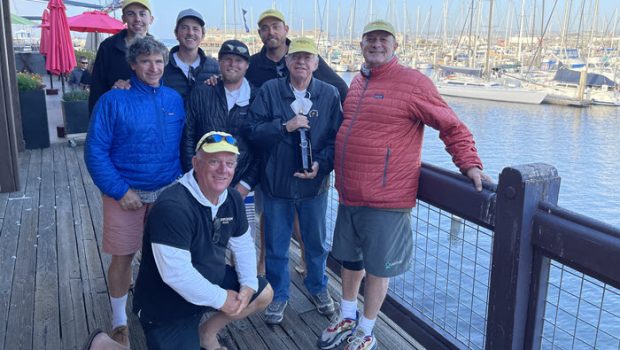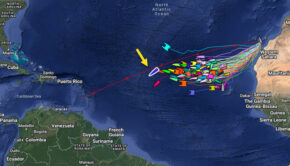When defecation hits rotary oscillator
Published on June 16th, 2021
The California Offshore Race Week combines three offshore sailing events, carrying the fleet from San Francisco to San Diego. For the 2021 edition, it was during the 204 nm second stage when things went quite wrong for one entrant. Len Bose shares the onboard account:
The Santa Cruz 50 Horizon was competing in the 2021 Coastal Cup between Monterey and San-ta Barbara with eight souls on board. The race started on May 31 with a heavy marine layer, and the weather forecast was predicting light variable winds down the course.
After the start, the winds shifted from 5 knots out of the South to 20+ knots out of the North with the fleet struggling to change from the #1 genoas to their #3 jibs and a reefed main. After four hours of pounding in the heavy seas, the breeze subsided down to 8-12 knots with the fleet headed out to sea.
As the sun set, the wind shifted back to the south with a heavy mist in the air dropping the temperature down to wet, cold, and miserable.
The weather condition stayed mostly the same throughout the following day, but during the previous night we fell into a hole and lost a large lead over our competitors in our division, with Oaxaca extending into a ten-mile advantage. For most of the second day, the two of us were reaching in light air under ten knots, with the margin between the boats growing and shrinking.
At 17:00 the sky cleared and the breeze slowly built out of the west to 15-20 knots, moving us to gybe towards the beach while Oaxaca headed out to sea. As we passed Big Sur, we had almost a two-knot speed advantage over our competitor, and when the two boats converged on Point Conception, it appeared we had taken the lead while holding on to its speed advantage.
The call was to gybe back into the breeze to keep our advantage, and this is when the defecation hit the rotary oscillator aboard Horizon.
Excitement and confidence were high on the boat that we would also have a chance on correcting out on Oaxaca. The breeze had slowly been building and we had changed from our 1.5 Spinnaker to our 2A about twenty minutes earlier and had just brought up on deck our 4A. The call was made to gybe and we went into our maneuver, but when the spinnaker clew had made it past the headstay and was on its way in, I noticed the main had not completed the gybe.
Just then we were hit by a 25 knot puff and the main violently gybed at the same time the chute filled on the new gybe. This caused us to round up violently into the wind with one crew member falling over the lifelines on the new weather side of the boat while still hanging on, then pulling himself back on board. At that moment, the call went out “Man overboard!”
During the gybe I had been knocked down to one knee at the helm, and while regaining my stance to both feet I hit the “Man Overboard Button” at the helm, then allowed the boat to return to head to wind. The man overboard button is interfaced with the GPS Chart plotter and pin-points the location of when the button was engaged, plotting the location on the screen. The time was 18:57:36 at 34:26.010 latitude, 120:27.702 longitude.
Two crew members were now on the back of the boat dispensing our man overboard gear “Life Sling” and “Throwable retrieve line” with one of the two crew members becoming the spotter along with another crew member at the helm pedestal.
I can still see the expression of the MOB’s face after I had brought the boat head to wind. There was no fear in his face yet concern on how he could make it to the MOB gear that was 25 feet away. It was instantly observed onboard that the MOB could not maneuver to the gear in the water.
Our bow team was extraordinarily efficient to bring down the spinnaker and gathering up all the lines, and following two line checks, the motor was turned on and engaged. We tacked the boat and then fell off the wind in a figure 8 pattern to pick up the MOB, positioning head to wind with the MOB on the starboard side of the boat amidships.
With the boat now in neutral, crew members started reaching for the MOB, handing him the life sling and retrieval line. But at this point, the boat started backing down faster than the MOB with the MOB floating around the bow of the boat and down the port side. None of the crew efforts were able to bring in the MOB while the boat floated away.
Seeing that the distance between us was gauging larger, and the MOB noticeably growing weak-er a volunteer, crew member Steven Natvig stripped down to his underwear, requested and put on my old fashioned dinghy life jacket, and along with taking the life sling in hand like a life-guard, jumped into the water to retrieve the MOB who was now fifty feet away port side aft quarter of the boat.
Natvig is 33 years old, 6’2″, an avid surfer, and in perfect health. In a few seconds, he had reached the MOB, stabilized him on his back while being pulled into the boat, and then quickly boarded the boat’s transom scope.
Our ETA into Santa Barbara Harbor was three hours when the crew had taken the MOB down below, removing his wet clothes and wrapping him in a heated vest, sleeping bags, and a wool hat. One crew member was observing the patient, another was obtaining medical advice for hypothermia with a third crew member contacting the race authorities. Being within cell phone range, we used the phone to contact the Coast Guard.
While contacting Coast Guard Command Center San Pedro, I was on the phone with Warrant Officer Josue Mendez. After reviewing the incident, we came to the questions regarding the patient, and I was able to get which medications he was on while describing his condition. When asked to take the patient’s pulse, I had no clue how to complete that task, but thankfully we had a crew member that knew how to take a pulse although unable to take it because the patient was trembling so badly.
We were now two hours out from Santa Barbara Harbor. Helicopter pickup was two hours away; boat pick up was the same. With the patient becoming more stable and completing full sentences, we elected not to receive any outside assistance. We had the patient sitting up while communicating with him. He then asked to go to the head, then getting dressed we thought we had solved our hypothermia problem. However, after a very short time being unwrapped, the patient began to shiver again while growing difficult to keep him awake.
All the covering went back on with a new concern of a relapse of hypothermia. We made contact again with Warrant Officer Josue Mendez to update him on the relapse; Mendez had called us back about a half-hour earlier for an update, and during this conversation Mendez quickly picked up our concern with the relapse while we reviewed the flight surgeons recommendations.
Tensions were eased with the patient’s response to our questions. One of the recommendations from Mendez was to refuel the patient with some type of food. “Do you have any bananas on board?” Mendez asked. My response … “This is a race boat, there are never any bananas on board!” Bananas are considered bad luck on race and fishing boats. Mendez gave us a courtesy laugh as a pressure release.
As we continued towards the harbor, the patient regained his warmth and we made plans on how we would get him off the boat. On arriving at the Santa Barbara guest dock, with all eight souls aboard, two paramedics were waiting for us then stepped on board as soon as the vessel was se-cured to the dock.
All the patient’s vitals were normal so there was no need to be transported to the local hospital for observation. The patient then took a three hour ride home in a heated car with a crew member where he was passed on to concerned family members.
The crew of Horizon responded quickly and efficiently to our MOB pre-race plans yet we can and will get better. Hoping we never have to go through that drill again.
Items to note:
1. Never let yourself be lulled into light conditions and not wear your life jacket.
2. The spotter has to stay focused and must not be distracted from the target.
3. All life-saving gear must be deployed. We never released our MOM.
4. We did have a life jacket on deck that a crew member could put on quickly and swim in.
5. The boat files should have a complete medical report for each crew member.
6. We were fortunate that our foredeck crew and pit person stayed on task to lower the foresails then bring in all the lines.
7. Communicating with the Coast Guard was simplified by talking over the phone. Before calling I had the boat’s Doc number, time, location of MOB, heading, and speed on a notepad before calling.
8. If this MOB had happened at night we would not have been successful; the proper lifejacket with AIS beacon would be needed.
9. Warrant Officer Josue Mendez did an outstanding job communicating with us and making us feel he was now part of our team, and onboard with us. He was tracking us on AIS the whole way in and also placed a follow-up call into us on our way into the harbor to check on the patient. This was a huge pressure release onboard know we had help on hand if needed.
10. We were extremely fortunate to have someone like Steve Natvig aboard who is skilled enough to jump in the water and rescue another crew member.
Above photo from left to right:
Back row: Kenneth Sherb, Chris Vilicich, Steven Natvig
Second row: Jamie Malm, Taylor Schlub, John Shulze, Peter Heck
Front row: Len Bose









 We’ll keep your information safe.
We’ll keep your information safe.